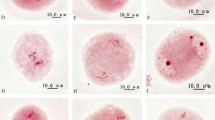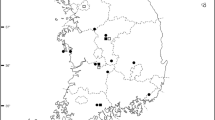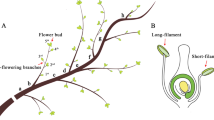Abstract
Sub-haploid pollen grains with chromosome numbers ranging from n = 5-12 were seen in the cultivar ‘Maulei’ ofPaphiopedilum insigne Pfitz. Many grains showed n = 5 and 6 (38%) while 3% showed a hyperploid number (n = 18, 20). It was also observed that pollen grains with the same chromosome number differed in karyotype.
The high percentage (81 %) of sub-haploid pollen grains in the present case may be due to the high degree of segregational irregularities during meiosis or to split spindle or failure of wall formation. It may also be due to changes in the environment of the species which may influence the metabolic activity responsible for the initiation and subsequent development of the cell wall and the process of chromosome duplication.
Similar content being viewed by others
References
Adams, H. H., 1954. Modern Cypripedium hybrids II. Cypripedium insigne. Am. Orchid Soc. Bull. 23: 95–196.
Afzelius, K., 1916. Zur Embryosackentwicklung der Orchideen. Svensk. Bot. Tidskr. 10: 183–227.
Barber, H. N., 1941. The pollen grain division in Orchidaceae. J. Genet. 42: 97–103.
Beeks, R. M., 1955. Improvement in the squash technique for plant chromosomes. El. Aliso 3: 131–134.
Belling, J., 1924. Detachment (elimination) of chromosomes in Cypripedium acaule. Bot. Gaz. 78: 458–460.
Brewbaker, J. L., 1967. The distribution and phylogenetic significance of binucleate and trinucleate pollen grain in the Angiosperms. Am. J. Bot. 54: 1069–1983.
Duncan, R. E., 1959. Orchids and cytology. Orchids scientific survey. Ronald Press, New York.
Eftimiu-Helm, P., 1941. Recherches sur les noyaux des orchidées. Botaniste 31: 65–111.
Francini, E., 1931. Ricerche embriologiche and cariologiche sul genere Cypripedium. Nuovo G. bot. ital. 38: 155–212.
Gohil, R. N. & Koul, A. K., 1981. Cytology of the tetraploid Allium chinense G. Don. Caryologia 34: 74–81.
Heslop-Harrison, J., 1966. Cytoplasmic connections between Angiosperm microcytes. Ann. Bot. 30: 221–230.
Karasawa, K., 1978. Karyomorphological studies of the interspecific variation of Paphiopedilum insigne. Kromosomo 11: 233–255.
Khoshoo, T. N., 1966. Cytology of pollen with particular reference to Impatiens and Alieae. Proc. Ind. Acad. Sci. LXIII: 35–45.
Mehlquist, G. A. L., 1947. Polyploidy in the genus Paphiopedilum Pfitz. (Cypripedium Hort) and its implications. Bull. Mo. bot. Gdn 35: 211–228.
Pal, M. & Khoshoo, T. N., 1972. Evolution and improvement of cultivated Amaranthus IV. Genetica 43: 119–129.
Raina, S. N. & Khoshoo, T. N., 1971. Cytogenetics of tropical bulbous ornamentals VIII. Genetica 42: 239–247.
Sapre, A. B., 1976. Sub haploid pollen in Aloe barbadensis. Curr. Sci. 46: 126- 127.
Sasa, S. & Torigata, H., 1967. Karyotype analysis of 6 species and 2 hybrids of Paphiopedilums. Jap. Orchid Soc. Bull. 13: 3–8.
Sharma, A. K., 1974. A quartercentury with chromosomes. Ind. Sci. Congr. Chandigarh.
Singh, F., 1980. Pollen cytology and its significance in the study of orchid chromosome. Natn. Symp. Orchids, UNDP/HHR, Bangalore-India pp. 40.
Singh, F., Ved Brat, S. & Khoshoo, T. N., 1967. Natural triploidy in viviparous onions. Cytologia 32: 516–520.
Süssenguth, 1921. Beiträge zur Frage des systematischen Anschlusses der Monokotylen. Beih. bot. Zbl. 38: 1–80.
Snoad, B., 1954. Abortive meiosis in plasmodial pollen mother cells of Helianthemum. Ann. Bot. N.S. 18: 1–6.
Tanaka, R. & Aoyama, M., 1974. Karyological studies in some species of Paphiopedilum. Jap. Orchid Soc. Bull. 20: 3–8.
Ved Brat, S., 1967. Genetic system in Allium IV. Balance in hybrids. Heredity 22: 387–96.
Vij, S. P. & Mehra, P. N., 1974. Cytological studies in the East Himalayan Orchidaceae III. Cypripedieae. Caryologia 27: 293–300.
Withner, C. L., Ed., 1974. Orchids, Scientific studies. John Wiley and Sons. Inc., New York.
Author information
Authors and Affiliations
Rights and permissions
About this article
Cite this article
Singh, F. Sub-haploid pollen inPaphiopedilum insigne (Orchidaceae). Genetica 67, 57–61 (1985). https://doi.org/10.1007/BF02424461
Received:
Accepted:
Issue Date:
DOI: https://doi.org/10.1007/BF02424461




